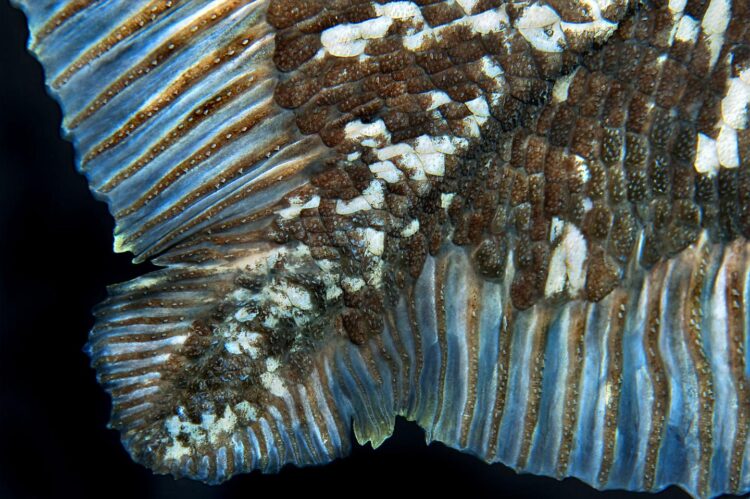Once thought to be extinct, lobe-finned coelacanths are enormous fish that live deep in the ocean. Now, researchers reporting in the journal Current Biology on June 17 have evidence that, in addition to their impressive size, coelacanths also can live for an impressively long time–perhaps nearly a century.
The researchers found that their oldest specimen was 84 years old. They also report that coelacanths live life extremely slowly in other ways, reaching maturity around the age of 55 and gestating their offspring for five years.
“Our most important finding is that the coelacanth’s age was underestimated by a factor of five,” says Kélig Mahé of IFREMER Channel and North Sea Fisheries Research Unit in Boulogne-sur-mer, France. “Our new age estimation allowed us to re-appraise the coelacanth’s body growth, which happens to be one of the slowest among marine fish of similar size, as well as other life-history traits, showing that the coelacanth’s life history is actually one of the slowest of all fish.”
Earlier studies attempted to age coelacanths by directly observing growth rings on the scales of a small sample of 12 specimens. Those studies led to the notion that the fish didn’t live more than 20 years. If that were the case, it would make coelacanths among the fastest-growing fish given their large size. That seemed surprising considering that the coelacanth’s other known biological and ecological features, including slow metabolism and low fecundity, were more typical of fish with slow life histories and slow growth like most other deep-water species.
In the new study, Mahé, along with co-authors Bruno Ernande and Marc Herbin, took advantage of the fact that the French National Museum of Natural History (Muséum National d’Histoire Naturelle de Paris, MNHN) has one of the largest collections of coelacanths in the world, ranging from embryos in utero to individuals of almost two meters. They were able to examine 27 specimens in all. They also used new methods, including polarized light microscopy and scale interpretation technology mastered at IFREMER’s Sclerochronology Centre, Boulogne-sur-mer, France, to estimate individuals’ age and body growth more precisely than before.
While earlier studies relied on more readily visible calcified structures called macro-circuli to age the coelacanths much as counting growth rings can age a tree, the new approaches allowed the researchers to pick up on much tinier and nearly imperceptible circuli on the scales. Their findings suggest that the coelacanths actually are about five times older than was previously thought.
“We demonstrated that these circuli were actually annual growth marks, whereas the previously observed macro-circuli were not,” Mahé says. “It meant that the maximum longevity of coelacanth was five times longer than previously thought, hence around a century.”
Their study of two embryos showed they were both about five years old. Using a growth model to back-calculate gestation length based on the size of offspring at birth, the researchers got the same answer. They now think that coelacanth offspring grow and develop for five years inside their mothers prior to birth.
“Coelacanth appears to have one of, if not the slowest life histories among marine fish, and close to those of deep-sea sharks and roughies,” Mahé says.
The researchers say that their findings have implications for the coelacanth’s conservation and future. They note that the African coelacanth is assessed as critically endangered in the Red List of Threatened Species of IUCN.
“Long-lived species characterized by slow life history and relatively low fecundity are known to be extremely vulnerable to perturbations of a natural or anthropic nature due to their very low replacement rate,” Mahé says. “Our results thus suggest that it may be even more threatened than expected due to its peculiar life history. Consequently, these new pieces of information on coelacanths’ biology and life history are essential to the conservation and management of this species.”
In future studies, they plan to perform microchemistry analyses on coelacanth scales to find out whether a coelacanth’s growth is related to temperature. The answer will provide some insight into the effects of global warming on this vulnerable species.
###
Current Biology, Mahé et al.: “New scale analyses reveal centenarian coelacanths Latimeria chalumnae” https://www.cell.com/current-biology/fulltext/S0960-9822(21)00752-1
Current Biology (@CurrentBiology), published by Cell Press, is a bimonthly journal that features papers across all areas of biology. Current Biology strives to foster communication across fields of biology, both by publishing important findings of general interest and through highly accessible front matter for non-specialists. Visit http://www.
Media Contact
Carly Britton
[email protected]
Related Journal Article
http://dx.





